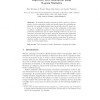Free Online Productivity Tools
i2Speak
i2Symbol
i2OCR
iTex2Img
iWeb2Print
iWeb2Shot
i2Type
iPdf2Split
iPdf2Merge
i2Bopomofo
i2Arabic
i2Style
i2Image
i2PDF
iLatex2Rtf
Sci2ools
124
click to vote
IBERAMIA
2010
Springer
2010
Springer
Improved Text Generation Using N-gram Statistics
Abstract. In Natural Language Generation (NLG) systems, a generalpurpose surface realisation module will usually require the underlying application to provide highly detailed input knowledge about the target sentence. As an attempt to reduce some of this complexity, in this paper we follow a traditional approach to NLG and present a number of experiments involving the use of n-gram language models as an aid to an otherwise rule-based text generation approach. By freeing the application from the burden of providing a linguistically- rich input specification, and also by taking some of the generation decisions away from the surface realisation module, we expect to make NLG techniques accessible to a wider range of potential applications. Key words: Text Generation, Surface Realisation, Language Modelling
Artificial Intelligence | Generalpurpose Surface Realisation | IBERAMIA 2010 | Natural Language Generation | Surface Realisation Module |
Related Content
| Added | 25 Jan 2011 |
| Updated | 25 Jan 2011 |
| Type | Journal |
| Year | 2010 |
| Where | IBERAMIA |
| Authors | Eder Miranda de Novais, Thiago Dias Tadeu, Ivandré Paraboni |
Comments (0)

